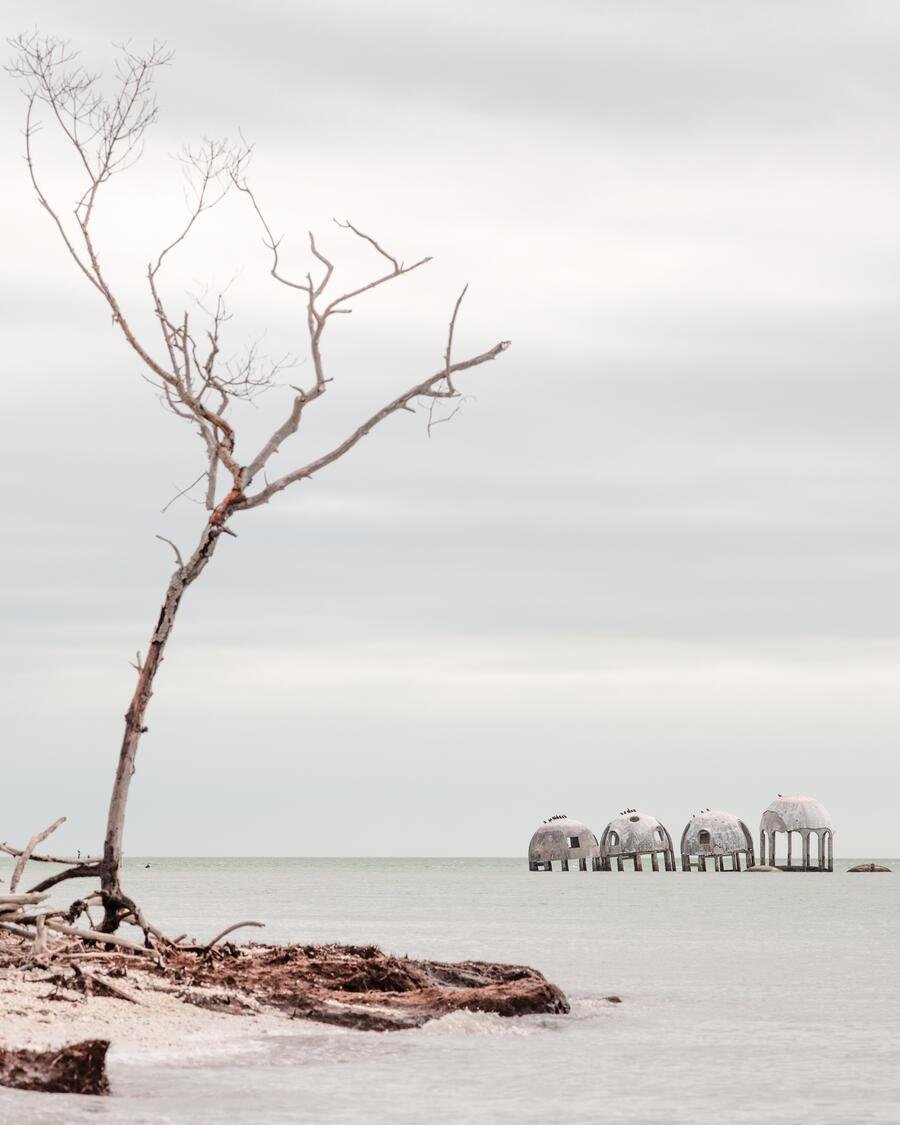Topic 9: NATURE and CULTURE
Photographing storms, Kerry, February 2022. Author’s image
The concept of nature hasn’t presented itself as a concern in my practice to date. Although I do make photographs of natural things these have been more for personal or recreational purposes. Nature, as a theme, was a small part of my series Someone Else’s, Somewhere (link here) however this work was primarily focused on the built environment. Having said this, I often have ideas for using the natural world in projects but worry that this type of work sits outside of my practice.
Issues of nature and culture have presented themselves to me almost serendipitously this week. I would like to use this post as an opportunity to make connections between these experiences and events with this week’s reading.
FloodZone by Anastasia Samoylova, Deutsche Börse Photography Foundation Prize 2022, installation detail at the Photographers Gallery, London. Author’s image
Samoylova’s work FloodZone at The Photographers Gallery touches on many of the themes highlighted in this topic. At the heart of this ongoing series is the impact of climate change on her adopted home of Florida. Samoylova’s photographs mostly urban scenes which have in some way been encroached by rising sea levels. These scenes are not in the usual vein of shocking climate catastrophe images as outlined by Born (2019). Rather, the evidence presented here is somewhat more benign: toppled palm trees, pink mould on concrete, a submerged underground carpark. These are everyday scene of climate change with small c’s. However, their very quotidian nature represents the very clear and present danger of the climate crisis. The seas won’t suddenly rise as in Hollywood disaster movies. They will do so incrementally. This is a slow motion disaster unfolding before us and Samoylova has captured it’s building tension and our growing environmental anxiety in this work.
The work is slickly presented. Large, crystal clear prints offer exotic views into the Florida swamps. The walls of the gallery were painted in dark greens and mauve. Light and heat seemed to radiate from her photographs and I could nearly believe that the heating was turned up. This suffocating atmosphere, mostly provoked through her images, was intoxicating. I was reminded of reading Ballard’s vision of a submerged London (1978) and how his writing expertly simulated the psychology of living in unapologetic tropical heat.
Anastasia Samoylova 2018. Dome House [from Floodzone].
Image available here.
Moreover, Samoylova’s photographs are expertly composed. They present rigid geometries which recite established pictorial tropes. They are in essence, picturesque. In this work she has found a way to make images of climate warming attractive. I don’t mean this in the sense that it’s a positive thing but more that she has made beautiful images of this horrendous event. Like Ballard’s book, despite the obvious risks you want to live, or at least visit this world. In this respect they summon the sublime.
I hadn’t considered that climate catastrophe as a sublime event, but of course it is. So grand in scale, so overarching and far-reaching it is perhaps the ultimate sublime event. In this work then, Samoylova answers Born’s call for a new visualisation of the climate crisis.
Lisa O'Carroll 2022. Tom Carney on the makeshift road that maintains access to his home
Available here
Born suggests this new visualisation requires the illustration of the interconnectedness of humanity and nature. I happened to come upon a newspaper article that does just that. When I think about the impact of climate warming I usually think of places like Florida, Australia or the Artic. However, this was a report from Co. Roscommon, Ireland. The local and personal effects of this flooding is well-illustrated through photographs and video. We are allowed to hear and see how this event has effected farmers and homeowners. There is little hyperbole and although this flooding cannot be linked to climate change definitively, it does fit in with the wider trend of anomalous global nature events.
Screengrab from satellite image from Flightradar24. Patchwork of fields south of Reims.
I encountered the sublime whilst flying home from Rome this week. This was my first flights in over 2 years so having a window seat I think I was a bit excited and spent most of the flight looking out at the unfolding landscape of Europe below. I’m sure I’m not alone in this pursuit but it is only now that I realise that this urge and the excitement one gets, looking down on the world from 30000 feet is exactly the same as standing on the precipice of the Grand Canyon. Added to this though is the sense that one should not be seeing the world, or ‘our’ world, from this perspective. There is something uncanny in this form of looking (Alexander 2015:74). I was particularly overwhelmed by the expanse for geometrically organised fields when flying over Northern France. The enormity of this organised agricultural landscape was shocking, yet beautiful at the same time. Like Samoylova’s depictions outlined above, the dichotomous feelings of awe and shock is very interesting. I wonder about this type of terraforming and can it continue if climate change is to be stopped?
Reading:
ALEXANDER, Jesse. 2015. ‘Defining Nature’ in Perspectives on Place Theory and Practice in Landscape Photography, 56-86. Available at: http://dx.doi.org/10.5040/9781474222372?locatt=label:secondary_appliedVisualArts [accessed 31 Mar 2022].
BALLARD, J. G. 1978. The Drowned World. London: V. Gollancz.
O’CARROLL, Lisa. 2022. ‘“Nobody Knows What Happened”: The Row over the Non-Vanishing Irish Lake’. The Guardian, 29 Mar [online]. Available at: https://www.theguardian.com/world/2022/mar/29/row-non-vanishing-irish-lake-lough-funshinagh-drain-flooding-environment-legal [accessed 31 Mar 2022].
‘Source Photographic Review - Back Issue Archive - Issue 99 Autumn 2019 - Feature Page - Nature Gone Wild? - Feature Article by Dorothea Born.’ 2022. [online]. Available at: https://www.source.ie/archive/issue99/is99feature_Dorothea_Born_12_19_24_24-03-21.php [accessed 31 Mar 2022].




